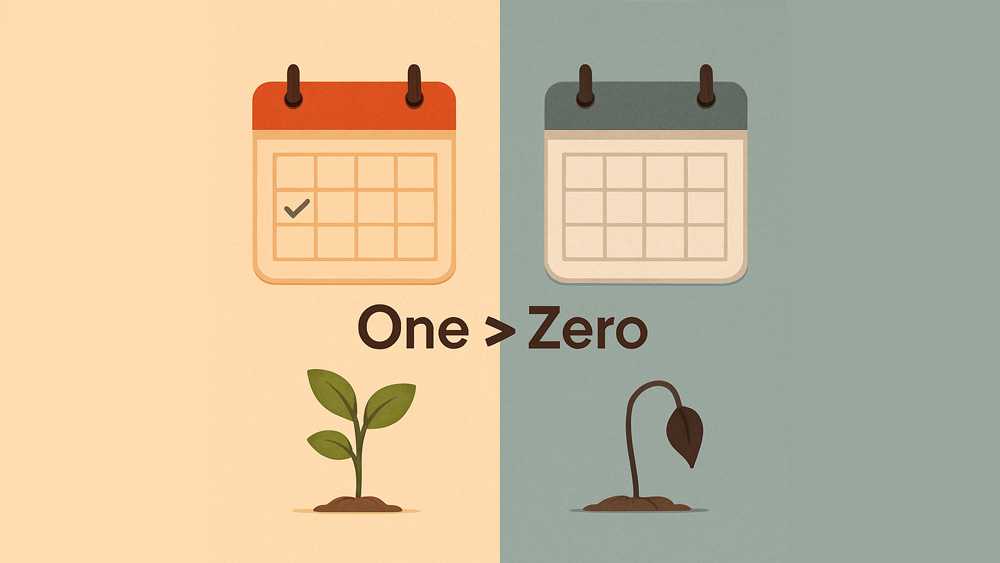Let’s be honest about something. Most people’s approach to discipline is completely broken. Not because they lack willpower or motivation. Not because they’re lazy or uncommitted.
But because they operate on a system that’s designed to make them fail.
It’s the all-or-nothing trap. The binary thinking that says you either crush your workout or you skip it entirely. You either meditate for 30 minutes or you don’t do it at all. You either journal extensively or the book stays closed.
This mindset isn’t just wrong. It’s a psychological death sentence for any meaningful change.
Why Most People Fail Before They Start
Look around and you’ll see people trapped in an endless cycle. They set ambitious targets, miss them for completely normal human reasons, then abandon the entire practice because they’ve “failed.” They get back on the horse a few days or weeks later, only to repeat the same pattern until they’re convinced discipline just “isn’t for them.”
But here’s the truth you need to hear. The problem was never your discipline. The problem was your broken measurement system.
When perfect execution is the only acceptable outcome, you’ve rigged the game against yourself from the start.
One Is Better Than Zero
The most transformative principle in building actual discipline isn’t some motivational nonsense about “grinding” or “hustling.” It’s much simpler and more confronting:
One is better than zero. Every time. Always.
One push-up is infinitely better than no push-up. One minute of meditation beats zero minutes every single time. One sentence written is measurably more productive than no writing at all.
This isn’t about lowering standards. It’s about understanding the vast psychological gulf between doing something, however minimal, and doing absolutely nothing.
Every time you hit zero, you reinforce the neural pathway of inaction. You strengthen the belief that you’re someone who doesn’t follow through. You make it exponentially harder to show up tomorrow.
Every time you do something, even something pathetically small, you maintain the thread of continuity. You preserve your identity as someone who shows up. You make it easier to continue.
The Ceiling and Floor Framework
This is where the concept of ceilings and floors becomes a game-changer. For every discipline in your life, stop setting one target. Set two:
The ceiling: What you aim for when conditions are optimal.
The floor: Your non-negotiable minimum when everything goes to shit.
The ceiling represents your best-case scenario. The 60-minute training session. The full meditation practice. The deep creative work. It’s what you push for when energy is high and time is available.
The floor is your emergency protocol. The bare minimum that still counts as showing up. The 5 minutes of movement. The three deep breaths. The single paragraph written. It’s what you fall back on when life is crushing you, but you refuse to hit zero.
The Framework for Mental Warfare
This approach becomes absolutely critical during mental health battles. Depression, anxiety, burnout – these states make ceiling-level performance nearly impossible. They drain the cognitive resources needed for ideal execution.
But floors? Floors remain accessible.
When anxiety has your mind racing in fifteen directions, a 60-minute workout feels like climbing Everest in flip-flops. But you can always do one set of push-ups. When depression feels like moving through concrete, writing 1,000 words seems laughable. But you can write one sentence.
The floor becomes your lifeline that maintains continuity when the ceiling feels unreachable.
And sometimes – not always, but sometimes – that pathetically low floor breaks the paralysis just enough that you end up doing more than the minimum. That’s a win you’d never experience if you insisted on the ceiling or nothing.
How to Implement This System
Setting effective ceilings and floors requires some serious honesty:
Your ceiling should challenge you but remain realistic. Not what you could theoretically accomplish in some fantasy world, but what you can actually achieve on a good but normal day.
Your floor must be laughably easy. If you’re thinking, “That’s too easy to even count,” you’ve got it right. The entire point is eliminating every possible excuse for hitting zero.
Your floor must maintain the essence of the practice. Reading about exercise isn’t a floor for working out. The floor must preserve the core activity, even if minimally.
Your floor must be doable in under five minutes. Any longer and it becomes a barrier when you’re at your lowest.
Some real examples:
Physical Training Ceiling: 60-minute structured workout Floor: 10 air squats or a 5-minute walk
Meditation Ceiling: 20 minutes of seated practice Floor: Three conscious breaths
Nutrition Ceiling: Balanced, home-prepared meals Floor: One vegetable with whatever else you’re eating
Work Performance Ceiling: 90 minutes of deep, focused work on your most important project Floor: Spend 5 minutes organizing tomorrow’s priorities or completing one tiny task
Relationships Ceiling: Quality time with full presence and meaningful conversation Floor: One genuine text acknowledging someone important to you
Beyond the Physical
This ceiling-floor approach extends beyond physical practices into every performance domain.
For leadership, your ceiling might be fully present, transformative conversations with your team. Your floor might be ensuring you make genuine eye contact with each person, even when you’re distracted or overwhelmed.
For relationships, your ceiling might be deep, vulnerable conversations. Your floor might be sending one text that says, “Thinking of you,” when your emotional tank is empty.
For learning, your ceiling might be an hour of focused study. Your floor might be reading a single page of a book.
The Truth About Momentum
The real power is in the elimination of zeros.
The person who does one push-up every day for a year is measurably stronger than the person who plans ambitious workouts but does nothing for months.
The writer who produces one paragraph daily will finish a book while the perfectionist who needs “ideal conditions” remains perpetually on page one.
This isn’t just about maintaining habits through difficult periods. It’s about the profound psychological shift that happens when you stop breaking promises to yourself. When you build an unbroken chain of showing up, even if sometimes that showing up is minimal.
The truth that nobody wants to hear? Success isn’t built on occasional heroic efforts. It’s built on eliminating zeros. On never completely breaking the chain. On understanding that movement – even microscopically small – is still movement.
The Challenge
Take one core discipline in your life right now. Set both your ceiling (ideal target) and your floor (non-negotiable minimum).
Make your floor so easy it seems ridiculous. Make it so simple you could do it on your absolute worst day.
Then commit to never hitting zero again.
Because one is better than zero. Today. Tomorrow. Always.
And the difference between something and nothing isn’t just mathematical. It’s the difference between becoming who you aspire to be and forever wondering why transformation remains just out of reach.
Stay safe.
And don’t forget to be awesome.







